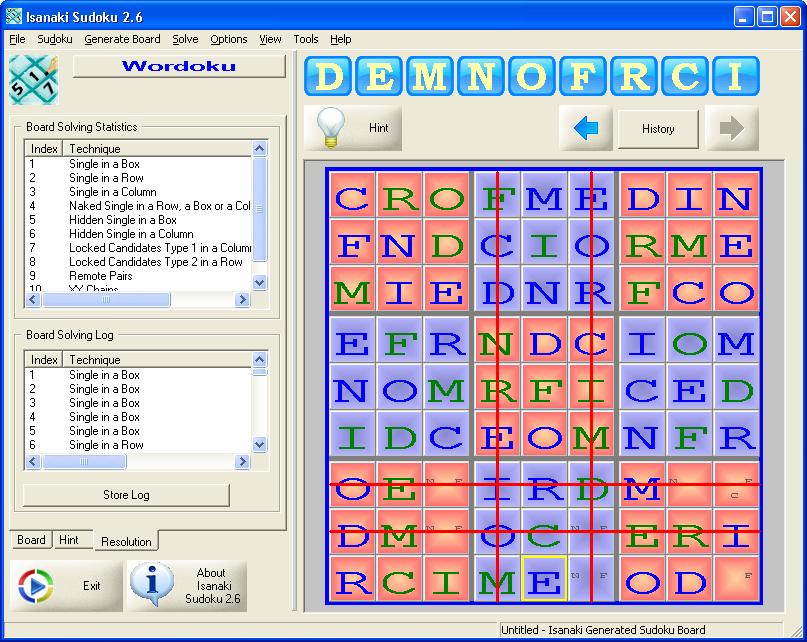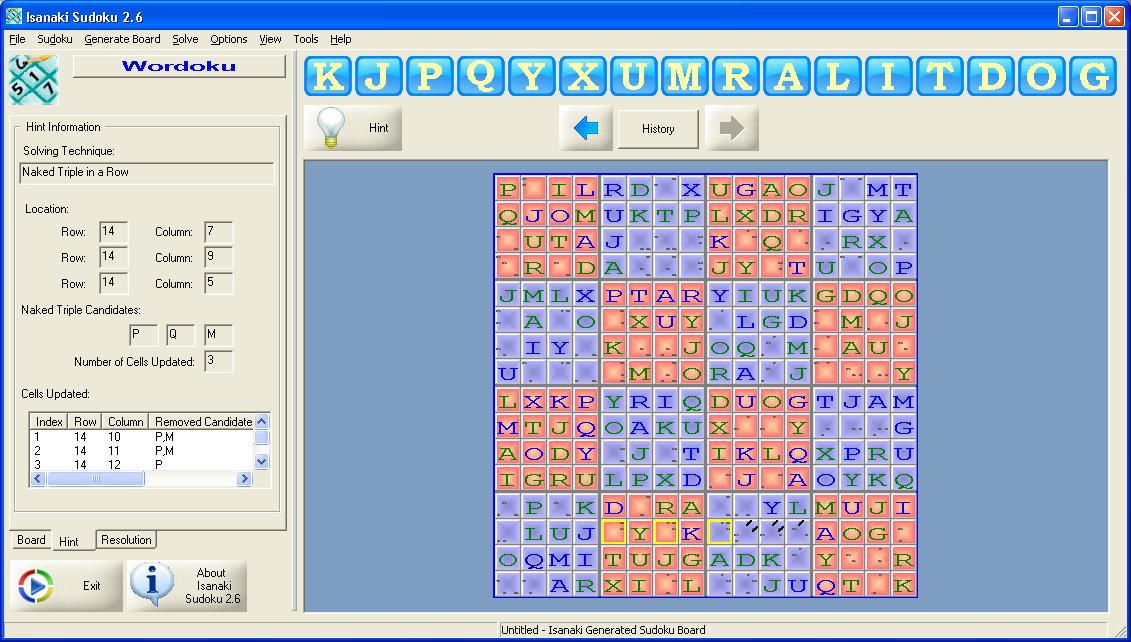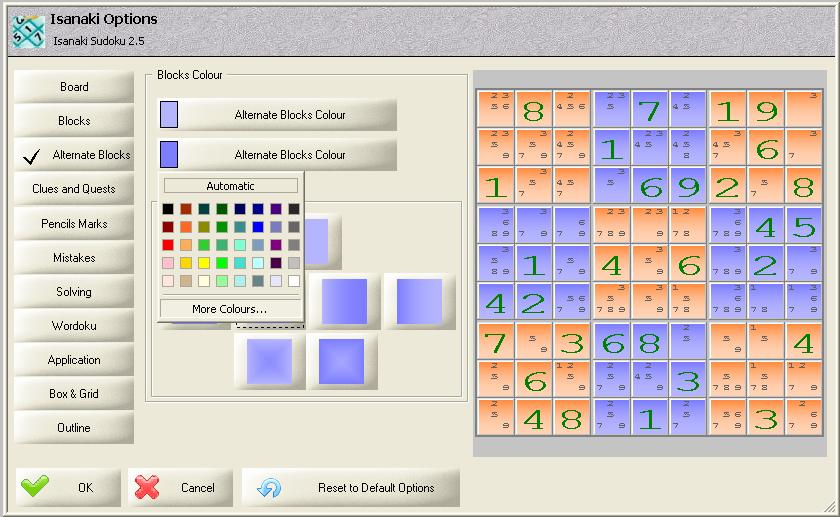Features of Isanaki 2.6b
- Terminology
- Support for 9*9 boards
- Support for 16*16 boards
- Wordoku Configuration
- Random Letters Assignment.
- Random Word Assignment.
- User-Defined Assignment.
- Randow: one of the rows, one of columns or one of the blocks of the board is selected randomly
- Defined: the assignment is located in a defined row, column or block
- Board Navigation
- Board Data Entry
- Switch the Board to Date Entry Mode and Type in the board data manually. To do this, select the menu 'Sudoku | Enter a New Board'
- Open a Sudoku Board from the Sudoku Board file handled by Isanaki 2.6b. This file is named BoardData.sbd and contains all the Boards Data previously saved.
- Import a Sudoku Board from a Sudoku Text File. Isanaki 2.6b attemps to read different kinds of Sudoku files (.txt .msk .sdk .sol .spf .ss) but their structure are not stricly defined
- Import a Sudoku Board from the clipboard. Isanaki 2.6b expects standard characters for empty cells ( either a dot, a 'X' or a '0') and attempts to handle different kinds of data structure.
- Pencil Marks
- Delete Erroneous Cells
- Keyboard accelerators
- CTRL+N: New Board
- CTRL+O: Open a Board
- CTRL+S: Save Current Board
- CTRL+I: Import Board from File
- CTRL+I: Export Board from File
- CTRL+P: Print Board
- CTRL+D: Default Board Generation (using the last type of board generated by Isanaki 2.6b)
- CTRL+G: Special Board Generation
- CTRL+H: Get Next Hint
- CTRL+Z: Undo
- CTRL+Y: Redo
- CTRL+J: Jump to Solving Technique
- CTRL+1: Switch to 16*16 Boards
- CTRL+9: Switch to 9*9 Boards
- CTRL+U: Check for Isanaki Sudoku Update
- CTRL+A: About Isanaki 2.6b
- Boards Zoom
- Undo and Redo
- Customization
- Background Colour
- Block Colour and Alternate Colour
- Clues and Quests Cells Colour
- Fading Style: Upside Down, Downside Up, LeftSide Right, RightSide Left, Inside Out, Outside In between Start and End Colours
- Wordoku Setup
- Pencil Marks Display
- Mistakes Warning
- Box and Grid: Seperator between blocks and Grid around Board
- Global Application Options: Play Sudoku Animation and Play Sound on Candidate Selection
- ...
- Boards Handling
- Boards Import
- Boards Export
- Web Friendly Format (.txt)
- VBForums Contest Format (.msk, .sol)
- SadMan Software Format (.sdk)
- Simple Sudoku Format (.ss)
- Boards Printing
- Board
- Blocks
- Alternate Blocks
- Clues and Quests
- Pencil Marks
- Mistakes
- Languages
- Update Checking
Just as a reminder, so that the wording is clear and precise...
A Sudoku Board is made up of cells (81 cells in a 9*9 Board and 256 cells in a 16*16 Board)
The board is divided in Rows (horizontal lines), Columns (vertical lines) and Boxes containing 9 (3*3) or 16 (4*4) cells.
The rows, columns and boxes are called Groups.
Every group must contain all the numbers from 1 to 9 ( in a 9*9 Board) or from 1 to 9 and A to G ( for 16*16 Board)
At the start, some cells are filled with numbers called Clues or Givens. The numbers added when solving the game are simply called solved cells. Interestingly, there seems to be no specific name for them. In Isanaki, I call them Quest cells."
Sudoku and Wordoku boards of any level of difficulty are supported by Isanaki 2.6b.
Sudoku 9*9 Boards that you fill with numbers from 1 to 9
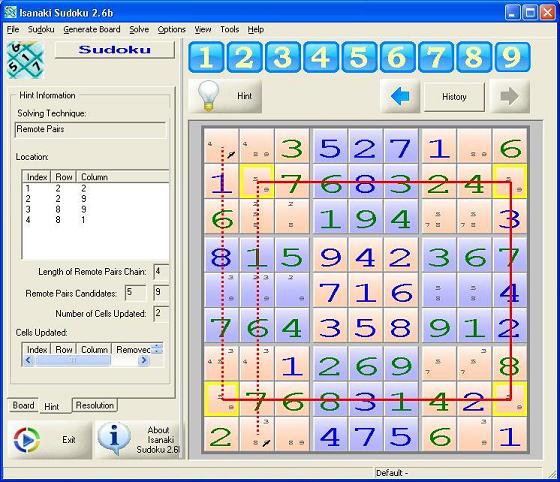
Wordoku 9*9 Boards that you fill with letters from A to Z (according to letters assignment)

Sudoku and Wordoku boards of any level of difficulty are supported by Isanaki 2.6b.
Sudoku 16*16 Boards that you fill with numbers from 1 to 9 and letters from A to G
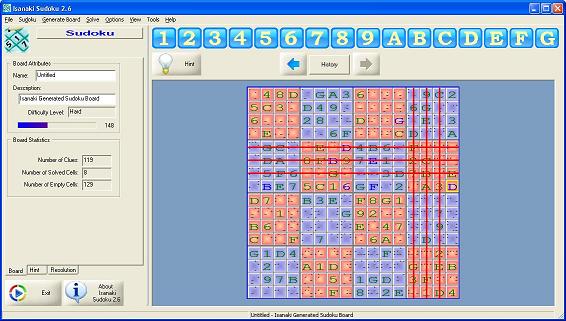
Wordoku 16*16 Boards that you fill with letters from A to Z (according to letters assignment

Note that attempt to generate 16*16 boards with high difficulty levels can be lengthy. A dialog box may appear to show progress of attempt...

Wordoku configuration provides much more options than Sudoku
Three assignments are available:
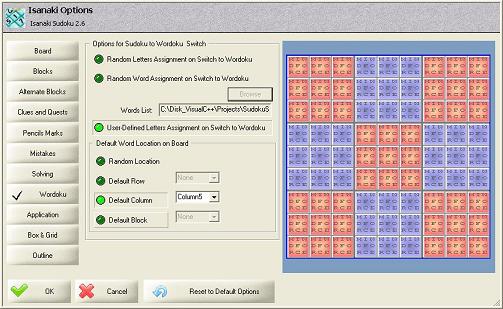
Also, the locations of the assigned letters can be :
When switching for the first time from Sudoku to Wordoku, Isanaki 2.6b will assign the letters according to the options selected. You can change the assignment at any time by selecting the menu 'Sudoku | Assign Wordoku Letters'...
Isanaki 2.6b provides flexible navigation in the board.
Navigating around the board can be done using the arrow keys (left and right keys to travel in the current row, up and down keys to travel in the current column) and the tab key (to cross the whole puzzle)
The application allows entry of a new board by four different ways:
During Board Entry Mode, the current cell is surrounded by a green border (but you can change this colour to fit your favorite colour)

Once the board is loaded, you can switch to Solve Mode by selecting the menu 'Sudoku | Solve the Board' and start resolving the board.
During the game, in Solve Mode, the current cell is surrounded by a blue border (but you can change this colour to fit your favorite colour)
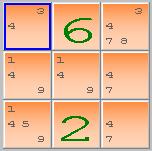
While you are playing, the application updates automatically the pencil marks in each cell of the board to show the remaining candidates..
| In a Sudoku board | 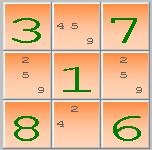 |
Or a Wordoku board | 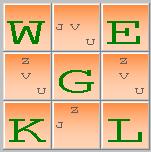 |
If you prefer the hard way, you can turn this feature off and hide the pencil marks ...
At any time, you can always delete a number inside the current cell by typing the 'Delete' key
Isanaki 2.6b supports keyboard accelerators
You can access several functionalities of the application without leaving your keyboard:
If your screen display does not fit yours eyes, try changing the zoom ... from 50% to 400%.
Isanaki 2.6b handles a 256-level of Undo-Redo.Whatever the source of the change (user entry, application hint or complete board solving), you can undo or redo it.

You can walk between the steps of the game using the arrows around the History button ...
Isanaki 2.6b supports full colour customization
You can change many options as:
Select the Menu 'Options | Board Options'

and change them to fit your needs.
At any time, you can Save the board for later use in a single file (BoardData.sbd) that can store dozens of boards ...
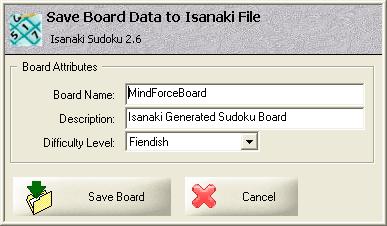
Using the BoardData file, you can store partly solved board, later retrieve the puzzle in the state you left it and continue the game
Boards can be imported manually from Isanaki binary file, text files (.txt .msk .sdk .sol .spf and .ss) and clipboard
Isanaki 2.6b can export boards data to Text File and/or to Clipboard

In both cases, four different formats are available:
Ex: ..4......5..61....12.5..67.3.9..1.2.......7.9....54..3........7..5..6.3....78.4..
..4...... 5..61.... 12.5..67. 3.9..1.2. ......7.9 ....54..3 ........7 ..5..6.3. ...78.4..
[Puzzle] ..4...... 5..61.... 12.5..67. 3.9..1.2. ......7.9 ....54..3 ........7 ..5..6.3. ...78.4..
*-----------* |..4|...|...| |5..|61.|...| |12.|5..|67.| |---+---+---| |3.9|..1|.2.| |...|...|7.9| |...|.54|..3| |---+---+---| |...|...|..7| |..5|..6|.3.| |...|78.|4..| *-----------*
Using Isanaki 2.6b, you can setup the way the boards are printed ....
Select the menu 'File | Board Page Setup'
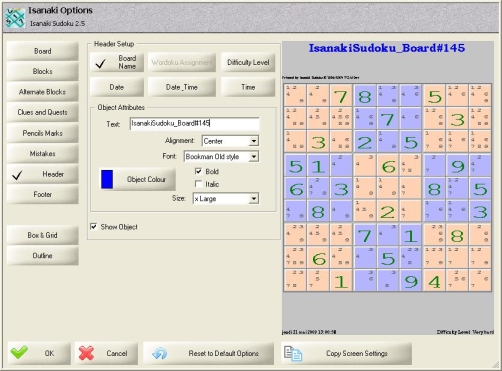
Using the dialog box, you can customize the boards printouts in the same way you customize screen display:
Using the same dialog box ...

You'll be able to specify board name, date, time and board level on either header or footer of the page .... as well as Separator Lines between blocks and around the board.
Since Isanaki Sudoku 2.4 is multilingual .... You can choose your prefered language by selecting the menu 'Tools | Languages'
 | English |
 | French |
 | Spanish |
 | Dutch |
Since release 2.4a, Isanaki Sudoku performs a self-check at startup to verify the version of the local copy versus the version available at the TGMDev Web Site.
Select the menu 'Help | Check for Isanaki Update' and verify the result on screen
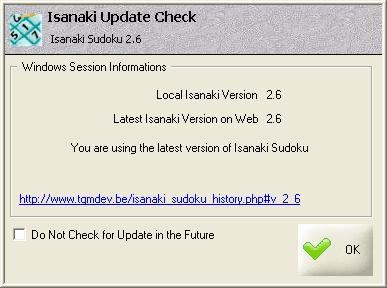
Jump to the Web Site if a new Version is available !!!

